Term 2 Unit 2 | History | 6th Social Science - Great Thinkers and New Faiths | 6th Social Science : History : Term 2 Unit 2 : Great Thinkers and New Faiths
Chapter: 6th Social Science : History : Term 2 Unit 2 : Great Thinkers and New Faiths
Great Thinkers and New Faiths
Unit 2
Great Thinkers and New Faiths

Learning Objectives
• To learn the causes for the rise
of new faiths in the sixth century BC
(BCE).
• To have knowledge in the teachings of Mahavira and Buddha.
• To know the similarities and dissimilarities between Jainism
and Buddhism.
• To understand the differences between Hinayana and Mahayana Buddhism.
• To know the influence of Jainism and Buddhism in Tamil Nadu.
Intellectual Awakening
The Sixth Century BC (BCE) is regarded as an
important period in the history of ancient India. As a land mark period in the
intellectual and spiritual development in India, historian Will Durant has
rightly called it the “shower of stars”.
Sources
Literary sources
•
Angas – Jain texts
•
Tripitakas and Jatakas - Buddhist texts
Causes for the Rise of Intellectual Awakening and the Birth of
Buddhism and Jainism
There
were several reasons for the rise of new intellectual awakening. Some of the
exploitative practices that paved way for new faiths include:
*
The complex rituals and sacrifices advocated in the later Vedic period
*
Expensive sacrificial ceremonies
*
Superstitious beliefs and practices that confused the common man.
*
Upanishads taught as alternative to sacrificial rites were too philosophical,
which a layperson could not understand.
*
Slavery, caste system, gender discrimination also contributed to the new
awakening.
Origin
of Jainism
Jainism is one of the world’s oldest living
religions. Jainism grounds itself in 24 Tirthankaras. A ‘Tirthankara’, is the
one who revealed religious truth at different times. The first Tirthankara was
Rishabha and the last one was Mahavira. Jainism gained prominence under the
aegis of Mahavira, during the sixth century BC (BCE).
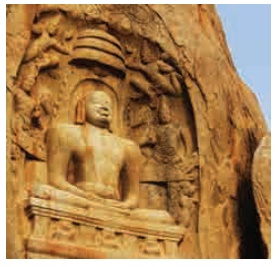
Original name - Vardhamana
Place of Birth - Kundhagrama nearVaishali, Bihar
Parents - Siddharth, Trishala
Place of Death - Pavapuri, Bihar
The word Jain derives from the Sanskrit word Jina, which means
conquering self and the external world.
Mahavira
(The Great Hero)
Vardhamana, meaning ‘prosperous’, was a
kshatriya prince. However, at the age of 30, he renounced his princely status
to adopt an ascetic life. He undertook intense meditation.
After twelve and a half years of rigorous
penance, Vardhamana attained omniscience or supreme knowledge, known as Kevala.
Omniscience – It is the ability to know everything
or be infinitely wise.
Thereafter, he became Jina meaning ‘one who
conquered worldly pleasure and attachment’. His followers are called Jains.
Mahavira reviewed the ancient Sramanic traditions and came up with new
doctrines. Therefore he is believed to be the real founder of Jainism.
Unique
Teachings of Jainism
* Jainism
denies God as the creator of Universe.
* Basic
philosophy of Jainism is Ahimsa or ‘non –Violence’.
* Ultimate
aim of Jainism is attaining moksha or ending the cycle of birth – death –
rebirth.
* Jains
reject the belief in Last judgement, where God, a supreme being, decides who
goes to heaven or hell.
* Jainism
advocates that the goodness or quality of one’s life is determined by one’s
karma.
What is Karma?
The belief that a person’s
actions in this life determine the quality of his or her later part of the
current life and the next incarnation.
Tri–rathnas or Three Jewels
Mahavira
exhorted the three – fold path for the attainment of moksha and for the
liberation from Karma.
They are:
•
Right Faith
•
Right Knowledge
•
Right action
Moksha - Liberation from the cycle of birth and death
Jain Code of Conduct
Mahavira
asked his followers to live a virtuous life. In order to live a life filled
with sound morals, he preached five major principles to follow.
They are:
•
Ahimsa - not to injure any living beings
•
Satya - to speak truth
•
Asteya - not to steal
•
Aparigraha - not to own property
•
Brahmacharya – Celibacy
Gautama Swami, a chief disciple of Mahavira, compiled the teachings of
Mahavira, called Agama sidhantha.
Digambaras
and Svetambaras
Jainism split into two sects.
Digambaras
* Digambaras are orthodox and conservative followers.
* Monks of the digambara sect, do not wear any
clothing and live naked. They are forbidden to have any kind of possessions.
* Digambaras believe that women cannot achieve
nirvana or liberation directly.
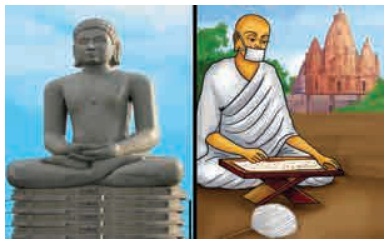
Svetambaras
*
The Svetambaras are considered progressive.
*
Monks of Svetambaras sect, wear white robes. They are permitted to have Rajoharana (broom with wollen threads),
begging bowl and book.
*
Svetambaras believe that women are equally capable of achieving liberation as
men.
Reasons for the Spread of Jainism
The
following are the main reasons for the wide acceptance of Jainism in India
*
Use of people’s language.
*
Intelligible teachings.
*
Support from rulers and traders.
*
Perseverance of Jain monks.
Influence of Jainism (Samanam) in Tamil Nadu
*
In ancient Tamil literature, Jainism is referred to as Samanam.
*
There is a Samanar Hill or Samanar Malai in Keelakuyilkudi village, 15 km away
from Madurai. The images of Tirthankaras created by Jain monks are found in the
hill. It is a protected monument of Archaeological Survey of India.
*
In Arittapatti, a small village 25 km from Madurai, on one side of Kalinjamalai
hill there are Jain caves called Pandavar Padukkai. Pandavar Padukkai is the
bed of Jain saints.
*
There is a reference to Aravor Palli, place of living for Jain monks, in
Manimegalai.
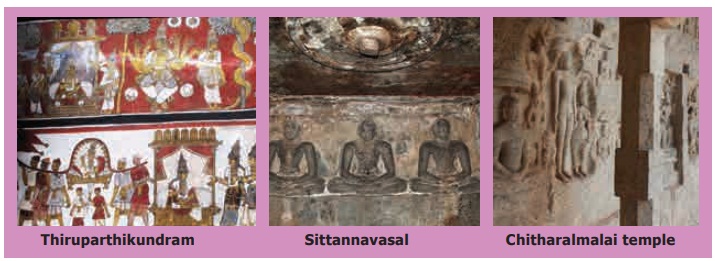
*
According to Silapathikaram, when Kovalan and Kannagi were on their way to
Madurai, Gownthiyadigal a female jain monk blessed the couple and accompanied
them.
*
Puhar, Uraiyur, Madurai, Vanchi (Karuvur), Kanchi all had Jain monasteries.
•
Jina Kanchi – Thiruparthikundram, a
village in Kanchipuram, has two ancient Jain temples. This village was once
called Jina Kanchi.
Buddhism
Gautama Buddha
Gautama
Buddha was the founder of Buddhism. His real name was Siddhartha. LikeMahavira,
he was also a Kshatriya prince belonging to the ruling Sakya clan. When
Siddhartha was only seven days old his mother died. So he was raised by his
step mother Gautami.
Four Great Sights
At
the age of 29, Siddhartha saw four sorrowful sights. They were:
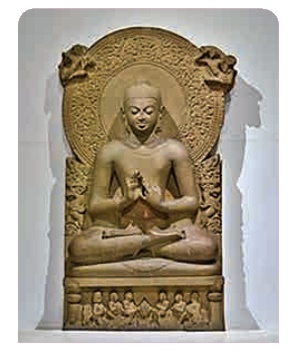
Original name - Siddhartha
Place of Birth - Lumbini Garden, Nepal
Parents - Suddhodana, Maya devi
Place of Death - Kushi Nagar, UP
*
An uncared old man in rags with his bent back.
*
An sick man suffering from an incurable disease.
*
A man’s corpse being carried to the burial ground by weeping relatives.
*
An ascetic
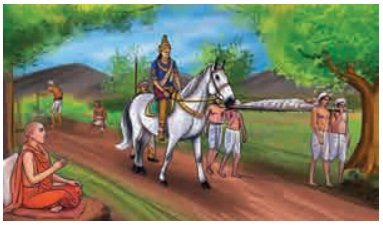
Enlightenment
Buddha, the Awakened or Enlightened One,
realised that the human life was full of misery and unhappiness. So at the age
of 29 he left his palace and became a hermit. He sacrificed six years of his
life towards penance. Nonetheless deciding that self-mortification was not a
path to salvation, Buddha sat under a Pipal tree and undertook a deep
meditation near Gaya.

On the 49th day he finally attained
enlightenment. From that moment onwards, he was called Buddha or the
Enlightened One. He was also known as Sakya Muni or Sage of Sakya clan.
Buddha delivered his first sermon at Deer Park
in Sarnath, near Benaras. This was called “Dharma Chakra Pravartana” or the
Turning of the Wheel of Law.
Buddha’s
Four Noble Truths
* Life
is full of sorrow and misery.
* Desire
is the cause of misery.
* Sorrows and sufferings can be removed by giving up
one’s desire.
* The desire can be overcome by following the right
path (Noble eight-fold path)
Eight
Fold Path
* Right
view
* Right
Thought
* Right
Speech
* Right
Action
* Right
Livelihood
* Right
Effort
* Right
Knowledge
* Right
Meditation
The teachings of Lord Buddha were simple and
taught in a language which people used for communication. Since the teachings
addressed the everyday concern of the people, they could relate to them. He was
opposed to rituals and sacrifices.
Teachings
of Buddha
* Buddha's teachings are referred to as dhamma.
* Buddhism accepted the Theory of Karma – meaning
that the quality of man’s life depends on his deed.
* Buddha
neither accepted nor denied the existence of God, but believed in the laws of
universe.
* Buddha asserted that attaining nirvana is the ultimate
aim of life.
* Buddha
advocated ahimsa or non-violence.
* Buddha had rejected the caste system.
The Wheel of life – represents the Buddhist view of the
world.
Buddhist
Sangha
Buddha laid foundation for a missionary
organization called Sangha, meaning ‘association’ for the propagation of his
faith. The members were called bhikshus (monks). They led a life of austerity.
Chaitya – A Buddhist shrine or a meditation hall.
Viharas – Monastries / livi quarters for monks.
Stupas – Built over the remains of Buddha’s body, they are
monuments of great artistic value.
Buddhist
Sects
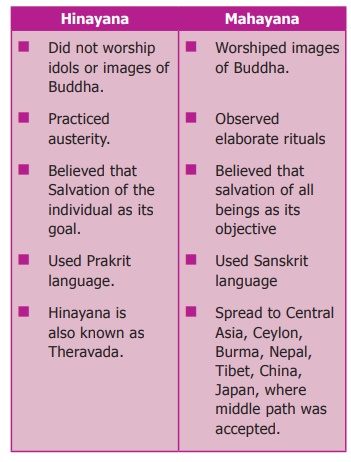
Causes for the Spread of Buddhism
*
Simplicity of the teachings of Buddha in local language appealed to people.
*
Buddhism rejected elaborate religious customs whereas the practice of orthodox
Vedic religion insisted on expensive rituals and sacrifices.
*
Buddha’s emphasis was on observance of Dhamma.
*
Buddhist Sanghas played an important role in spreading the messages of Buddha.
*
Royal patronage under Ashoka, Kanishka and Harsha also helped the causes of
Buddhism.
*
Viharas or the Buddhist monasteries became great centres of education. One such
centre was Nalanda, where Hiuen Tsang, the Chinese pilgrim, studied for many
years.
Frescoes
(paintings)
Frescoes on the ceilings and walls of the Ajanta caves in
Aurangabad, Maharashtra – depict the Jataka Tales.
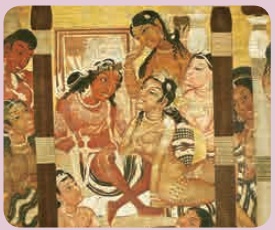
Middle path – It refers to neither indulging in extreme attachment to
worldly pleasure nor committing severe penance.

Buddhist Councils
First – Rajagriha
Second – Vaishali
Third – Pataliputra
Fourth – Kashmir
Influence
of Buddhism in Tamilnadu
* Buddhism
spread to Tamil Nadu much later than Jainism.
* Manimekalai, one of the epics of the
post-Sangam age is a Buddhist literature.
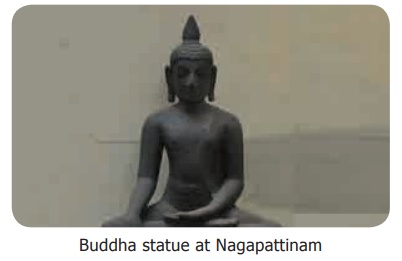
* There is an elaborate description about Kanchiipuram
in classical epic Manimegalai.
* Kanchipuram
was a famous Buddhist Centre, from where Dinnaga, the famous Buddhist logician,
and Dharmapala, a great scholar of Nalanda University hailed.
* Hieun Tsang who visited Kanchipuram in the
seventh century A.D(CE). noticed the presence of 100 feet stupa built by Ashoka
there.
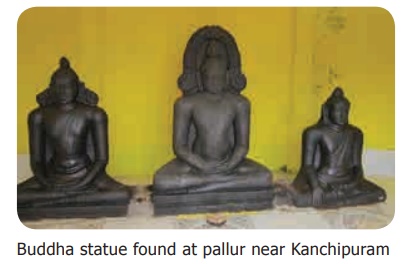
Jataka Story
The Jatakas are popular stories about the previous birth and
life of Buddha, as human and as an animal. They teach morals.
The Woodpecker and
the Lion (A Jataka Story)

Once upon a time, there lived a woodpecker and a lion. One day, the lion hunted a big bison and sat down to eat it. It so happened that while having his meal, a bigbone got stuck in the lion’s throat. He was not able to remove it and was in great pain.
A kind hearted woodpecker offered to help the lion. The
woodpecker, however, told the lion that he would only take out the bone if the
lion promised not to eat him while removing the bone. The lion gladly agreed
and opened his mouth in front of the woodpecker. The woodpecker hopped inside
the lion’s mouth, andeasily pulled out the bone. The lion kept his promise and
let the woodpecker fly away.

Soon the lion recovered completely and killed another bison. The
woodpecker also thought of joining the lion and asked for a small share of
meat. To her utter disappointment the lion blatantly refused to share his meal
with her. The Lion said, “How dare you ask me for more favours? I have already
done so much for you!”

The woodpecker did not understand what the lion was talking
about. The lionthen clarified, “You should be thankful to me that I did not
devour you when you were taking out the bone from my throat. Now do not expect
anything else from me and go away.” The woodpecker said to himself, “It was
indeed a mistake to help such an ungrateful creature!” Nevertheless, it is not
worth being angry or holding grudge against someone as unworthy as him.

Summary
*
The Sixth century BC (BCE) was an important period of the intellectual and
spiritual development in India.
*
Jainism was a doctrine developed by 24 Tirthankaras.
*
Mahavira exhorted the three-fold path – Right faith, Right knowledge, Right
action.
*
Gautama Buddha was the founder of Buddhism.
*
Buddha’s teachings are referred to as dhamma.
*
Buddhism crossed the frontiers of Indian sub-continent but Jainism was confined
to India.
*
Basic philosophy of Jainism and Buddhism is ahimsa or non-violence
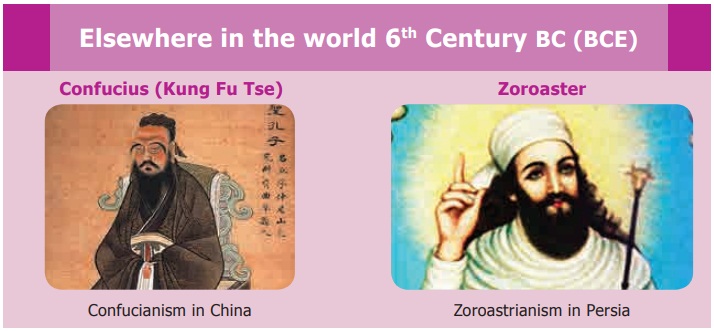
GLOSSARY
Superstitious beliefs – belief
in things that are not real or possible (மூடநம்பிக்கைகைகள்)
Preceptor - a
teacher or instructor (ஆசான்)
Doctrine - set of
principles or beliefs
Virtuous - having
high moral standards (நல்லொழுக்கம்)
Sacred book - holy
book (புனித நூல்)
Frescoes - a
painting done in water colour on wet plaster (ஈரமான சுவற்றில்
வண்ணக் கலவை கைாண்டு வரையப்ட்ட ஓவியங்கள்)
Corpse - a dead
body (சடலம்)
Nirvana - A
state of freedom from suffering and rebirth
ICT CORNER
Virtual Tour of Sittanavasal
Through
this activity you will be able to see Virtual Tour about Cave Paintings in
Tamil Nadu
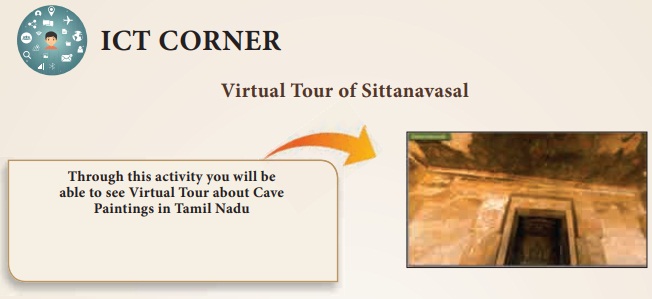
Step-1:
Open the Browser and type the URL or scan QR code which is given below.
Step-2:
You can see Virtual Tour website. Click to allow “Adobe Flash Player” on the
screen.
Step-3:
Open “slide view” in menu bar and acces s control button
Step-4:
Click “Red Arrow Button” you can see cave paintings

URL:
http://view360.in/virtualtour/sithannavasal/
Related Topics